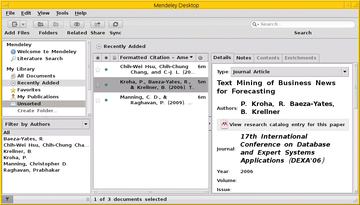Managing electronic references
|
Zotero
Zotero [22] is very popular, but goes in a totally different direction. Developed by the Center for History and New Media at George Mason University, it manages references as so-called bookmarks that you create in your web browser.
Zotero has split into two different branches. One is Zotero for Firefox [23], which extends the Firefox/Iceweasel web browser, and the other is called Zotero Standalone. Both branches are free software and are available on a PPA for Ubuntu. To install, do the following:
$ sudo add-apt-repository ppa:smathot/cogscinl $ sudo apt-get update $ sudo apt-get install zotero-standalone
Zotero scans for bibliographic metadata in websites or COinS (see below). When it finds them, the web page adds an extra symbol next to the address field. In Figure 6, you can see a little book symbol. When you click on this, Zotero extracts the embedded metadata in the web page and adds it to the local resources database (see Figure 7).
To extract scientifically accurate, correct, and complete references from the stored metadata, open the Zotero Standalone program. In the three-column format, your collection is shown on the left, in the middle are the references, and on the right are the details for the selected reference.
Figure 8 shows the dialog for selecting the format Zotero uses to convert the metadata. You get the selection by right-clicking for the context menu and using the Export Selected Entry option. For BibTeX format, you get output as in Figure 9.
Web and Cloud-Based Solutions
Several commercial solutions are available for capturing and maintaining your references in an integrated platform. Some of the most interesting are those that provide a central data repository, a complete text processing tool, and tools for knowledge organizations and scheduling and planning.
Depending on the version, platform, and license, they may also provide collaborative functions for joint document editing. The top dogs among the research platforms in certain languages include Citavi [24] and Mendeley [25], with Refeus [26] providing some competition.
Citavi is based on the .NET framework and, therefore, native to the Windows platform. Mendeley sees itself as a content manager for an academic, social network where users exchange information and are apprised of the latest research results.
The software, called Mendeley Desktop, is available for Ubuntu (32-bit and 64-bit) from the project webpage. Requirements include registering on the website. The user interface is similar to that of JabRef.
Figure 10 shows a list of recently added documents and their references. You can export this data very easily, for example, into BibTeX format or XML for EndNote [27]. Access is facilitated through Droideley [28], a free app for the Android smartphone.
Refeus is developed by a startup from Brandenburg and is marketed as a tool supporting "the entire process of collecting and managing content and sources all the way to writing and publishing scientific documents and other material" [26]. Refeus, therefore, combines a text editor based on OpenOffice and LibreOffice with a document and source management in a single, unified user interface.
Refeus is available as a free Refeus Basic version and a cost-based Refeus Plus version from its website. You can find software packages for Ubuntu 12.04, 14.04 and up, as well as for Mac OS X and Microsoft Windows.
All your data is stored using the free object-based ODABA [29] database. The package includes two very interesting features: an app for your smartphone and a plugin for the web browser. The app is called Refeus Mobile and makes it easier to grab sources on the go (Figure 11).
The plugin called Refeus WebCollect is similar to Zotero and gathers the collected data in an inventory. (See the "Technologies for Automating Source Collection" for additional information.)
Automating Source Collections
Typing entries is a thing of the past. Nowadays, besides capturing them with QR codes, other technologies, such as COinS and DOI, are available for capturing sources automatically. These tools are based on the growing proliferation of mobile devices with daily Internet access.
The Context Objects in Spans (COinS) protocol describes integrating bibliographic metadata in (static) webpages [30], a directive built into the context of OpenURL 1.0. COinS are defined in "<span>" elements that have no effect on browser output [31]. Listing 4 shows the definition for a Z388 class with an ISBN of 1056-4438 to identify journals or a publishing series.
You can read this information using a browser plugin like Zotero (for Firefox) or Citavi (for Firefox, IE, and Google Chrome). Several Internet providers already support COinS, including various library catalogs and collaborative platforms such as Citebase [32], WorldCat [33], Mendeley, and ResearchGate [34]. A few additional plugins are available for WordPress, so that you can enhance your publications and use them with Zotero [35].
Digital Object Identifiers (DOIs) are object identifiers with which you can clearly identify physical, digital, or abstract objects. They have similarities with ISBN and ISSN but also integrate a function for localization. The previous application was for online articles for professional scientific journals. A few tools can process DOIs, among them JabRef, Zotero, Refeus, and the Citavi Picker.
Listing 4
COinS in Span Elements
<span class="Z3988" title="ctx_ver=Z39.88-2004&rft_val_fmt=info%3Aofi%2Ffmt%3Akev%3Amtx%3A journal&rft.issn=1045-4438">
Buy this article as PDF
Pages: 6
(incl. VAT)











